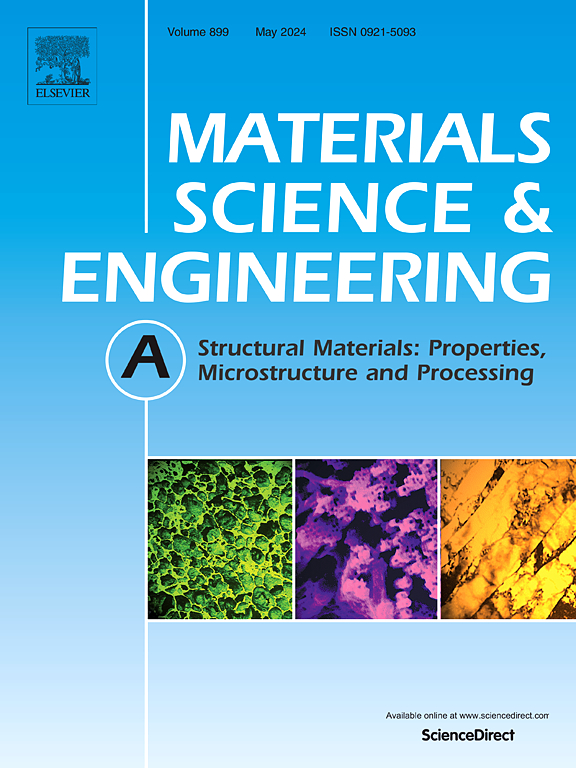Laser remelting driven synergy of ordered precipitation strengthening and sub-grain structure for enhanced strength-toughness in K447A superalloy
IF 7
2区 材料科学
Q1 MATERIALS SCIENCE, MULTIDISCIPLINARY
引用次数: 0
Abstract
This study investigated the laser surface remelting (LSR) of non-weldable K447A superalloy castings to repair damaged surfaces and enhance the mechanical properties of the remelted layers. The results indicated a significant improvement in hardness, room temperature, and 760 °C high-temperature tensile properties of the LSR layer. The LSR process reduced element segregation, allowing for increased solid solution of elements such as Al, Ti, and Ta. This led to an increase in the volume fraction of γ′ phase and the anti-phase boundary (APB) energy, resulting in a 37.7 % improvement in the yield strength of the LSR layer. During tensile deformation, the remelted structure more readily formed dislocation forest, causing local differences in strain hardening rates and inducing sub-grain formation. The sub-grain structure provided an additional mechanism for strain coordination, alleviating local stress concentration, thus improving toughness under 25 °C tensile conditions. At 760 °C, sub-grain boundaries underwent dynamic recrystallization driven by the combined effects of thermal activation and tensile stress, which reduced stress concentration by eliminating deformation energy, resulting in stress relaxation and thus enhancing the high-temperature tensile toughness of the LSR layer. During room temperature tensile, the interaction between dislocations and γ′ precipitates in the base material (BM) and LSR samples followed the APB strongly coupled dislocation shear mechanism. At 760 °C high-temperature tensile, the activation of more slip systems and the thermal activation of dislocations led to dislocation climb, cross-slip, Orowan bypass, and stacking fault shear mechanism, which dominated 760 °C high-temperature plastic deformation.

激光重熔驱动有序析出强化与亚晶组织协同增强K447A高温合金的强度-韧性
研究了不可焊K447A高温合金铸件的激光表面重熔(LSR),以修复损伤表面,提高重熔层的力学性能。结果表明,LSR层的硬度、室温和760℃高温拉伸性能均有显著提高。LSR工艺减少了元素偏析,增加了Al、Ti和Ta等元素的固溶体。这导致了γ′相体积分数和反相边界(APB)能量的增加,导致LSR层的屈服强度提高了37.7%。在拉伸变形过程中,重熔组织更容易形成位错林,导致应变硬化速率的局部差异,并诱发亚晶的形成。亚晶结构提供了额外的应变协调机制,减轻了局部应力集中,从而提高了25℃拉伸条件下的韧性。在760℃时,在热激活和拉应力的共同作用下,亚晶界发生动态再结晶,通过消除变形能降低应力集中,导致应力松弛,从而提高了LSR层的高温拉伸韧性。在室温拉伸过程中,基底材料(BM)和LSR样品中的位错与γ′相的相互作用遵循APB强耦合位错剪切机制。在760℃高温拉伸下,更多滑移体系的激活和位错的热激活导致位错爬升、交叉滑移、Orowan旁路和堆积断层剪切机制主导了760℃高温塑性变形。
本文章由计算机程序翻译,如有差异,请以英文原文为准。
求助全文
约1分钟内获得全文
求助全文
来源期刊

Materials Science and Engineering: A
工程技术-材料科学:综合
CiteScore
11.50
自引率
15.60%
发文量
1811
审稿时长
31 days
期刊介绍:
Materials Science and Engineering A provides an international medium for the publication of theoretical and experimental studies related to the load-bearing capacity of materials as influenced by their basic properties, processing history, microstructure and operating environment. Appropriate submissions to Materials Science and Engineering A should include scientific and/or engineering factors which affect the microstructure - strength relationships of materials and report the changes to mechanical behavior.
 求助内容:
求助内容: 应助结果提醒方式:
应助结果提醒方式:


